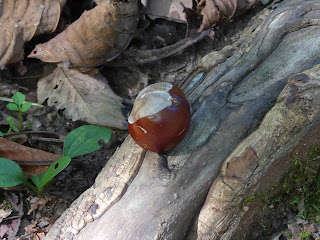Horse Chestnut Seed
I came upon a Horse Chestnut tree last autumn. Though their seeds have a superficial resemblance to the American Chestnut, there are lots of differences:
- American Chestnuts are in the same family as oaks and beeches, while Horse Chestnuts are in the same family as maples.
- American Chestnuts are native to much of North America; Horse Chestnuts are native to southern Europe.
- American Chestnuts are hard to find due to being devastated by chestnut blight; Horse Chestnuts in the US are not uncommon.
- While the seeds of American Chestnuts used to be a good food source for us and many other animals, Horse Chestnut seeds are poisonous to most birds/mammals.
Here's the inner part of a Horse Chestnut seed. I'm assuming that wild animals know not to eat them despite them looking a bit like a cap-less acorn. I've read that these seeds are toxic when fresh but lose their toxicity when they start to germinate, and that crows and jays will sometimes bury them and then go back to eat them when they're ready to germinate.
 |
| September 27, 2022 at Duke Farms Photo 248785576, (c) jpviolette, some rights reserved (CC BY-NC) |
Notice this branch has "side branches" that are on opposite sides of the main branch. Opposite branching is a slightly unusual branching technique; most trees exhibit "alternate branching" where you'll see a single side branch, then further out you'll see another side branch on the other side of the main branch.
Most of the trees you're likely to see growing wild in NJ follow the "MAD Horse Rule", where the letters in "mad" and the word "horse" list the opposite branching:
- M - Maple trees
- A - Ashe trees
- D - Dogwood trees
- Horse - Horse Chestnut trees
 |
| September 27, 2022 at Duke Farms Photo 248785580, (c) jpviolette, some rights reserved (CC BY-NC) |
Another good clue to the identity of a Horse Chestnut tree is found in the leaves, which are palmately compound. The center of this picture isn't of 6 separate leaves; it's of 1 leaf with 6 leaflets. This type of leaf, consisting of multiple leaflets, is called a compound leaf. And the way the leaflets spread out from the leaf center (a little like fingers spread out from your palm) additionally makes it palmately compound. No other tree in NJ exhibits both opposite branching and palmately compound leaves.
 |
| September 27, 2022 at Duke Farms Photo 248785589, (c) jpviolette, some rights reserved (CC BY-NC) |



Comments
Post a Comment